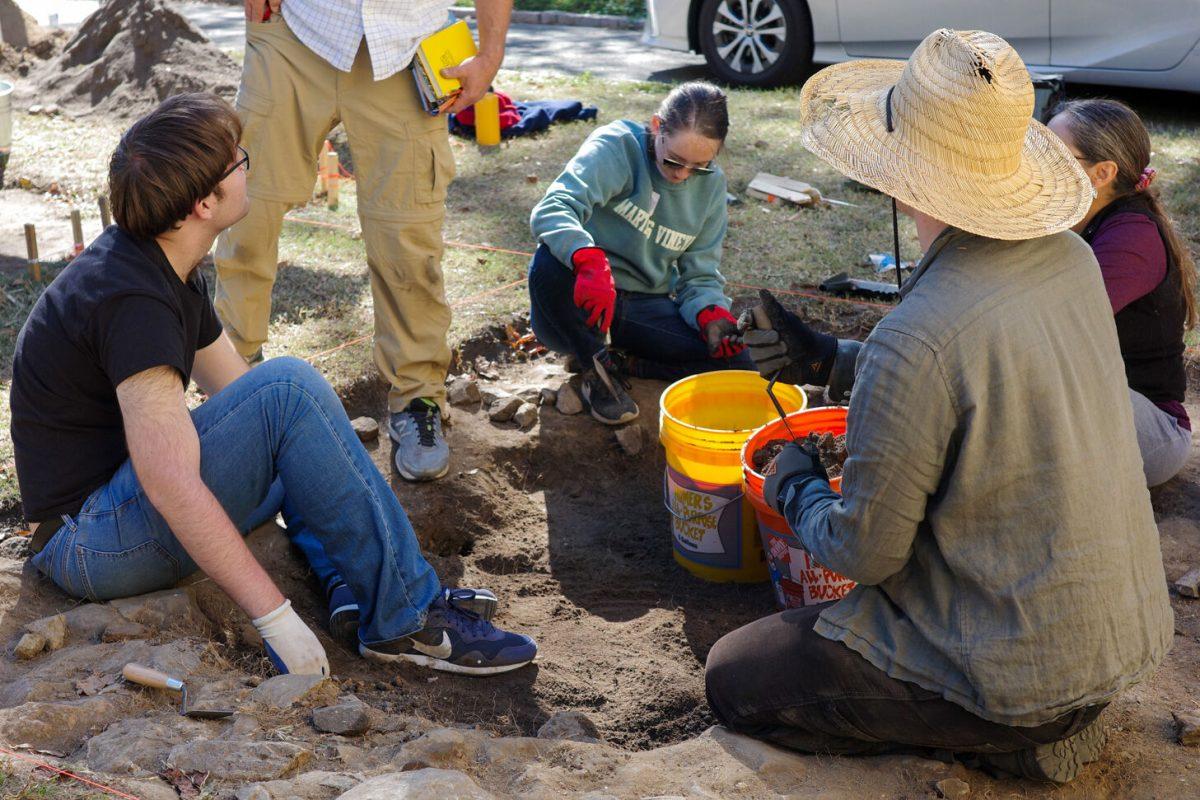An archaeological excavation at Mordecai Historic Park is unearthing layers of rich history that have remained untouched for decades.
John Millhauser, an associate professor in the Department of Sociology and Anthropology, is leading the dig from Oct. 4 to Nov. 9, along with NC State students.
The Mordecai House, built by Joel Lane after American independence, is the oldest house in Raleigh still standing on its original foundation. It became the Mordecai House when Moses Mordecai married into the Lane family, eventually becoming the largest plantation in Wake County with up to 200 enslaved people at its peak.
The property remained in the family until the late 1960s when it was sold to Raleigh and developed as a historic park.
The current excavation was prompted by the discovery of old bricks by an electrical crew. The Office of State Archaeology determined the bricks dated back to the 19th century and could be the foundation of the original detached kitchen.
“Back in the day, having a detached kitchen was a kind of luxury, because it kept vermin and smoke out of your house,” Millhauser said. “It kept heat out of your house in the height of the summer, and it also reduced the risk of burning your house down.”
The Office of State Archeology contacted NC State, and have since been working in partnership to investigate the site.
Upon investigation, the team found evidence of cooking in the original site of the kitchen.
“There was animal bone coming up, things that would be left over from cooking,” Millhauser said.
Since its founding, the focus of the Mordecai Historic Park shifted from telling the story of the Mordecais and the surrounding historical neighborhood to the stories of the underrepresented.
“As the park has changed over the years in terms of its goals, they’ve turned towards telling more the 19th century story of all the people who were here, including the enslaved people,” Millhauser said.
Recent discoveries have allowed the narrative to shift towards stories that haven’t been told before — those of the enslaved people kept on the property.
“We have window glass, we have nails, we have all kinds of construction debris, bones,” Millhauser said. “We have broken pottery and glass, things that you’d find in a home. Some of it is from last year, but this is an active park, and that’s part of the story. Some of it is from the 20th century when this was a neighborhood that was growing. And a lot of it is from the 19th century.”
Travis Corwin, a graduate student studying historic archeology, said his interest in the work stems from the curiosity that arises every time he uncovers something new.
“It’s just interesting to piece together that little puzzle piece of the past as you keep finding stuff,” Corwin said. “You encounter something that’s strange, and you just keep working around. Constantly things are making you question, and you have to figure out answers.”
An unexpected discovery was that of indigenous objects. The group uncovered an arrowhead that Millhauser estimated to be between 3,000 and 4,000 years old.
“People have been living here for thousands of years,” Millhauser said. “Multiple indigenous groups, the Catawba, the Lumbee, the Tuscarora.”
There’s always potential for unforeseen discovery in archeology, and Millhauser thinks that’s what makes it so important.
“Most people don’t get written about,” Millhauser said. “Most people, historically, couldn’t read or write either. Being able to investigate the material things that people made and used and left behind opens up a far wider range of lived experience in the past.”
Since the beginning of the partnership between NC State and the park, investigations involving three different faculty and two classes in the past spring have been conducted. A class with professor DelWayne Bohnenstiehl in the Department of Marine, Earth and Atmospheric Sciences used applied geophysics techniques to do an initial assessment of what was under the ground.
The excavation itself started in May 2024. There were volunteers from the Department of Anthropology in the summer, and the current dig has upwards of 50 volunteers coming by from NC State and the city of Raleigh.
After the dig is complete, the materials collected will go back to the historical park’s lab. An NC State anthropology class about collections management will then use the materials to learn and apply techniques of curation and cataloging. From there, Millhauser said that, ultimately, the fate of the artifacts is the park’s choice.
“They’ll take the lead in how they choose to share them and use them to tell the stories of all the different people who lived here.”
The Mordecai Historic Park is in contact with descendant communities of those who worked at the house, and now different tribal organizations in the Triangle, making sure their interests are well-represented.
Charity Sullivan, a graduate student studying anthropology who was volunteering at the dig, said this kind of work is important for telling stories that are historically underrepresented.
“It gives them a chance to learn their history as well,” Sullivan said.
Millhauser agreed that learning the whole story, not just fragments, is important to people today.
“I believe that there are merits in trying to learn about as many different people in the past as we can, to understand all the ways that they work,” Millhauser said. “Whether that story is the presence of indigenous people here, and potentially the continuing importance of this place to indigenous people, or the lives of enslaved people, or all the different people whose lives are intersected here. I believe there’s value in that, and in doing it well.”








